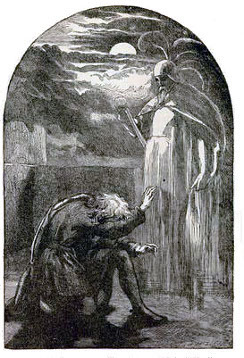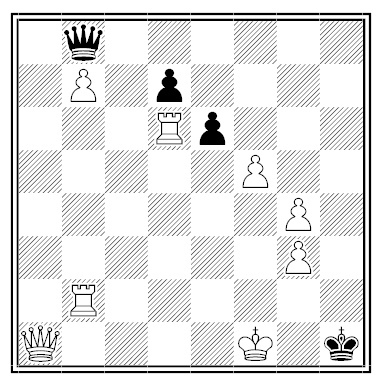BROBDINGNAGIAN and LUMBERING both contain BIG.
CLOSEMOUTHED and UNCOMMUNICATIVE both contain MUTE.
EXHILARATION AND EXULTATION both contain ELATION.
FOUNDATION and FOUNTAIN both contain FONT.
IMPAIR and MALFORM both contain MAR.
IRRITATED and INFURIATED both contain IRATE.
JOINED and CONFEDERATED both contain ONE.
JOLLITY and JOCULARITY both contain JOY.
LATEST and LEAST both contain LAST.
LIGHTED and ILLUMINATED both contain LIT.
NOUGAT and NEUROTIC both contain NUT.
OBSERVE and SPECTATE both contain SEE.
PLAYFULNESS and FACETIOUSNESS both contain FUN.
POSTURED and POSITIONED both contain POSED.
PURGED and PASTEURIZED both contain PURE.
RAMPAGE and RAVAGE both contain RAGE.
UNANIMITY and UNIFORMITY both contain UNITY.
SLIPPERY, STEALTHY, and SLINKY all contain SLY.
TRANSGRESSIONS, PERVERSIONS, and MISDOINGS all contain SINS.
Good Point

People go into ecstasies over the famous soliloquy ‘To be or not to be.’ I cannot myself know if our souls are annihilated after death or not. But if any one is well informed upon that point, it is Hamlet, who talks every day with his defunct father.
— Victorien Sardou, quoted in William Shepard Walsh, Handy-Book of Literary Curiosities, 1892
Cabooses
Square either of these 100-digit numbers and the result will terminate with the original number:
395300731910816980293850989006216650958086381100055742342323089610900
4106619977392256259918212890625
604699268089183019706149010993783349041913618899944257657676910389099
5893380022607743740081787109376
Truncate either one from the left, by any number of digits, and it will retain this property.
A Starlight Tour
A remarkable instance of a sleep-walker came well authenticated, during the course of the month. Between eleven and twelve o’clock, a boy who serves the bricklayers in Maidstone, got out of bed in his sleep, went through a casement, and walked over the ridges of several houses, after which he returned, and came in at the same window, where he awaked in great tremor, occasioned by a fall on his entrance; this extraordinary circumstance happened in sight of several spectators, one of whom, not knowing him to be in a dormant state, had in contemplation a design of firing at him with a gun, from a conclusion that he intended to break into some house; but seeing him return, without any attempt to effect such a purpose, both parties think themselves happy at the interposition of Providence, to prevent so dreadful a catastrophe.
— Gentleman’s Magazine, August 1786
In Other Words
Miami University French professor Howard Chace composed stories in what he called the “Anguish languish” to show the importance of intonation in conveying meaning. This example, “Ladle Rat Rotten Hut,” was written in 1940 and appeared subsequently in the Los Angeles Times. Read it aloud:
Wants pawn term, dare worsted ladle gull hoe lift wetter murder inner ladle cordage honor itch offer lodge dock florist. Disc ladle gull orphan worry ladle cluck wetter putty rat hut, end fur disc raisin, pimple colder ladle rat rotten hut.
Wan moaning rat rotten hut’s murder colder inset: “Ladle rat rotten hut, heresy ladle basking winsome burden barter an shirker car keys. Tick disc ladle basking tudor cordage offer groin murder honor udder site offer florist. Shaker lake, dun stopper laundry wrote, end yonder nor sorghum stenches dun stopper torque wet strainers.”
“Hoe-cake, murder,” resplendent ladle rat rotten hut, end tickle ladle basking an stuttered oft. Honor wrote tudor cordage offer groin murder, ladle rat rotten hut mitten anamolous woof. “Wail, wail, wail,” set disc wicket woof, “evanescent ladle rat rotten hut! Wares oar putty ladle gull goring wizard ladle basking?”
“Armor goring tumor groin murder’s,” reprisal ladle gull. “Grammar’s seeking bet. Armor ticking arson burden barter end shirker car keys.”
“O hoe! Heifer blessing woke,” setter wicket woof, butter taught tomb sheft, “Oil tickle shirt court tudor cordage offer groin murder. Oil ketchup wetter letter, an den — O bore!”
Soda wicket woof tucker shirt court, end whinny retched a cordage offer groin murder, hee picket inner widow end sore debtor pore oil worming wurst lion inner bet. Inner flesh, disc abdominal woof lipped honor betting adder rope. Zany pool dawn err groin murder’s nut cup an gnat gun, any curdled dope inner bet.
Inner ladle wile, ladle rat rotten hut a raft attar cordage end ranker dough bill. “Comb ink, sweat hard,” setter wicket woof, disgracing is verse. Ladle rat rotten hut entity bet rum end stud buyer groin murder’s bet.
“O Grammar,” crater ladle gull, “Wart bag icy gut! A nervous sausage bag ice!”
“Buttered lucky chew whiff, doling,” whiskered disc ratchet woof, wetter wicked small.
“O Grammar, water bag noise! A nervous sore suture anomalous prognosis!”
“Buttered small your whiff,” inserter woof, ants mouse worse waddling.
“O Grammar, water bag mousey gut! A nervous sore suture bag mouse!”
Daze worry on forger nut gulls lest warts. Oil offer sodden, throne offer carvers and sprinkling otter bet, disc curl and bloat Thursday woof ceased pore ladle rat rotten hut an garbled erupt.
Mural: Yonder nor sorghum stenches shut ladle gulls stopper torque wet strainers.
The Potato Paradox

You have 100 pounds of Martian potatoes, which are 99 percent water by weight. You let them dehydrate until they’re 98 percent water. How much do they weigh now?
Seafood Delivery
Sometime about the 22d of September 1810, Mr. Elisha Wall and his family, consisting of his wife and three grown children, besides several small ones, at his plantation, on Cypress Creek, about 12 miles from Coosawatchie-bridge, in South Carolina, saw passing over his yard, considerably below the height of the trees, on Sunday, directly after dinner, a prodigious quantity of narrow-headed cat-fish, of two sizes, the lesser quantity about two feet long, and the greater about one foot. The largest fish were as walls of defence, on either side of the small ones, about three yards in breadth, and three tiers deep — they were well arranged, in a small distance from each other, so as each to have room to use their fins and tails, without interfering with each other — they were nearly one hour moving slowly from east to west — they had all the motions of real living fish in their natural element, though there was neither cloud nor wind to support their movements. It is said that several thousands must have passed during the time they were viewed. Mr. Wall is an honest man, of truth, sobriety, and industry, whose word in any case, will not be disputed by those who know him — there were also at his house, at the time, five indifferent persons, who also saw this great phenomenon, and are willing, if necessary, to make oath to the fact herein stated.
— “American Papers,” quoted in Kirby’s Wonderful and Eccentric Museum, 1820
In a Word
kidsman
n. a trainer of young thieves
Reflections
I’m not sure who originated this — “Hiawatha at Miami,” a tale of auto-repair skulduggery. Composed entirely in letters with left-right symmetry, it was typed with a normal keyboard but must be read in a mirror:
OTTO TUOHTIW OTUA TAHT HTIW
IIAWAH TA AHTAWAIH
–!IXAT A TAHW — IXAT A TIH
.IMAIM TA ATOYOT A
:YVI OT WOV I TUH A TA
.IXAT A TIH AHTAWAIH”
HATU OT TUO TI WOT YAM I
“!YXAW OOT — WOT OT TIAW YAM I
IXAT A HTIW OTTO TUOHTIW
IIAWAH TA AHTAWAIH
-IXAM A — AMIXAM A TIH
!IMAIM TA (OTUA YM) AM
:AVA HTIW TUH A TA MA I
.OTUA YM TIH AHTAWAIH”
.ITIHAT OT TI WOT YAM I
“.OTTO OT TOOT OT TIAW YAM I
AHTAWAIH HTIW YOT YAM I
.OIHO — AWOI TA TUO
IXAT HTOMMAM TAHT WOT YAM I
.UHAO OT — IIAWAH OT
In the same spirit, here’s an equation discovered by Royal V. Heath:
1118 + 1881 + 8181 + 8818 = 1181 + 1818 + 8118 + 8881
Reverse that and you get:
1888 + 8118 + 8181 + 1811 = 8188 + 1818 + 1881 + 8111
Both equations remain true if you square all their terms.

